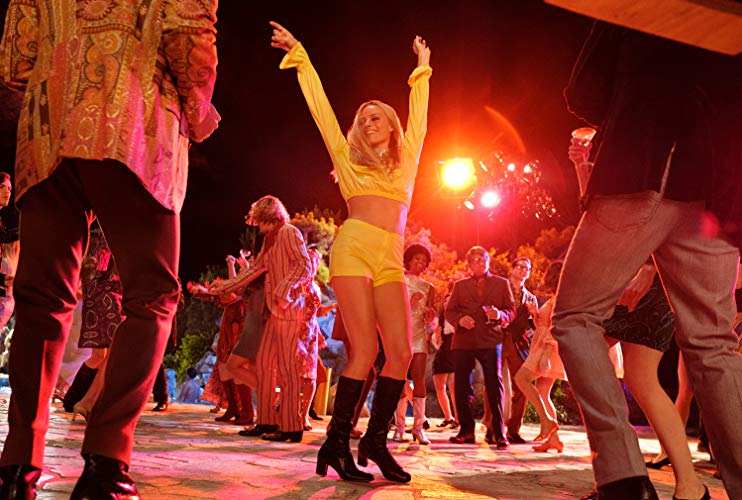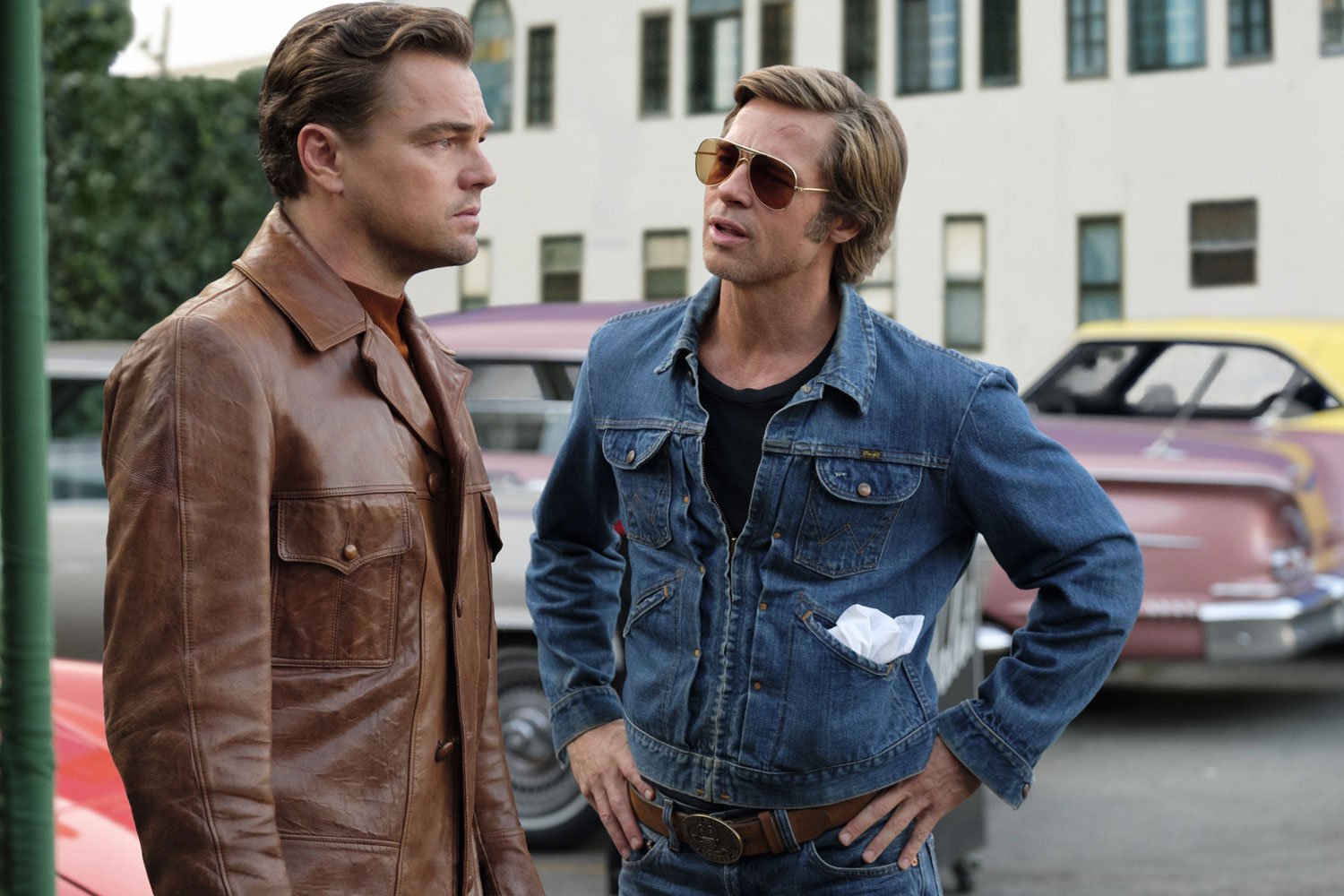
Leonardo DiCaprio and Brad Pitt in Once Upon a Time … in Hollywood / Sony Pictures Entertainment
It’s a shame when your most anticipated movie of the year is sort of a dud, particularly when it is from writer-director Quentin Tarantino, and it stars Brad Pitt and Leonardo DiCaprio.
That’s my overwhelming reaction to “Once Upon a Time in Hollywood,” Tarantino’s ninth film which clocks in at a meandering 2 hours and 41 minutes. I’d argue the director himself spoiled the film doing publicity work by comparing liberties taken with the climax of the movie to the artistic license he expressed in his 2009 film “Inglourious Basterds.” By Tarantino letting on that all might not occur as it did in history, as a viewer you’re waiting for a twist instead of being surprised by it.
Set in 1969 Hollywood, Tarantino couldn’t help himself from involving the infamous Manson Family murders in the film. Actress Sharon Tate was eight-and-a-half months pregnant when Manson Family members murdered her, her unborn child and three others during a home invasion that stands as one of the most hauntingly grisly crimes in American history.
Margot Robbie co-stars as Tate, and Pitt’s character stuntman Cliff Booth has a run-in with the Manson Family in the film. With Tate as a key character and the Manson Family as part of the movie, Tarantino sets the table for what should have been a dynamic third act.
However, the setup just takes too long and never really congeals with his tangential style of storytelling.
When the twisty climax does come, its effect is diminished by knowing that Tarantino is going to play fast and loose with history. Instead of inducing shock, anger, disgust, or joy, the violent and profane ending merits a chuckle or two. That’s about it.

Margot Robbie in Once Upon a Time … in Hollywood / Sony Pictures Entertainment
Again, that’s a shame because the film — at its best — is Tarantino’s love letter to the Hollywood of his youth, filmmaking, and the actors, movies, and TV shows that he loves and have influenced his nearly three-decade career as perhaps the film industry’s most stylized and at times interesting director.
This probably is his most personal movie, and aspects of it are terrific, but as a whole, the film was too scattered and blasé to knit together as a cohesive whole.
The crux of the movie is the friendship between Pitt’s Cliff and DiCaprio’s character TV Western star Rick Dalton. The relationship is based on actor Burt Reynolds’ relationship with his stuntman Hal Needham.
Like Reynolds, DiCaprio’s Dalton struggles with his career after leaving a successful TV series to make films. When his movies fizzle, Dalton is forced to go the TV guest-star route as the heavy of the week, and then go to Italy to star in second-class spaghetti westerns. All along his pal Cliff is in his corner, reassuring Dalton of his talent and ability.
Pitt and DiCaprio are both excellent in the film. Pitt has been the coolest guy in Hollywood since his star-making turn in 1991’s “Thelma and Louis,” and he still is under Tarantino’s direction. DiCaprio’s Dalton isn’t quite the man’s man he portrays on TV. He’s insecure and needy, and DiCaprio is all together believable as the character who’s awkward off screen but totally owns the moments when in front of a camera.
Even if I didn’t appreciate the movie as a whole, it’s undeniable how well DiCaprio and Pitt work together and apart in their roles. Their on-screen chemistry just pops. I hope this isn’t their final movie together.

Brad Pitt and Leonardo DiCaprio in Once Upon a Time … in Hollywood / Sony Pictures Entertainment
Maybe a sequel is in order. While the movie ends with Dalton and Cliff down on their luck, the 1970s turned out to be a fantastic decade for Reynolds and Needham. Reynolds switched to comedies and became one of the biggest stars of the 1970s, and Needham carved out an impressive career as a writer and director, mostly working with Reynolds.
Perhaps if Tarantino had not felt compelled to weave the Manson Family and Tate into the narrative, this film might have worked better as a story of friendship and the changes and challenges nearly everyone faces in a career. However, Tarantino couldn’t help himself.
The trouble is that Tarantino has become so predictable in his desire to be unpredictable that it seems he may be wallowing a bit as a writer-director just like his character Rick Dalton did as an actor.
That said, the movie looks great under the lens of cinematographer Robert Richardson, and Tarantino’s insistence to shoot with film rather than digitally gives the movie a grain that is just perfect for a picture set in 1969.
The period cars, storefronts and Hollywood landmarks give the film a true atmosphere of the city and the time, and the soundtrack drips with authenticity from a time when the diversity of music on the radio was electrifying.
Tarantino’s craft may be the most evident in Robbie’s scenes as Tate. Her dialogue is minimal, but Robbie and Tarantino are able to get so much across from her posture, body language, and facial expressions that we feel we know her character as the “It Girl” of the moment, and the camera just loves Robbie, as has been evident since her star turn in 2013’s “The Wolf of Wall Street.”
Taken as pieces there is so much I like about this movie, but when added all together, the movie left me dissatisfied and a bit sad Tarantino couldn’t pull it all together.
(R) 2 hr. 41 min.
Grade: C
Classic Corner: The Muppet Movie

Henson/Disney
Almost everyone with a heart and a sense of humor loves and appreciates Jim Henson’s Muppets.
Though they’ve been a fixture on television since the 1950s, Kermit the Frog and his pals grew to fame on Sesame Street starting in 1969 and reached the height of their popularity in 1979 when they not only appeared on their syndicated series “The Muppet Show” but also made it to the big screen with “The Muppet Movie.”
In conjunction with the 40th anniversary of the film’s release, the Malco Razorback Cinema and Grill is holding a special big-screen showing of the movie at 7 p.m. Tuesday. The classic movie not only details how Kermit the Frog made it from a Florida swamp to Hollywood, but also how he met his co-stars Miss Piggy, Fozzie Bear, Gonzo the Great, Rowlf and the rest.
The film is structured as a road comedy featuring the special brand of self-referential humor and parody that made the Muppets beloved by kids and adults alike.
Like all proper road movies, the film featured a heavy dose of cameos from the biggest and most popular comedians of the day, including Madeline Kahn, Steve Martin, Richard Pryor, Mel Brooks, Milton Berle, Dom De Luise, Bob Hope, Edgar Bergen and Charlie McCarthy, and Carol Kane, as well as personalities such as James Coburn, Elliott Gould, Orson Wells, Charles Durning, Cloris Leachman, and Telly Savalas.
The Muppets are all their adorable selves, and the jokes mostly hit their marks, but perhaps what stands out most is the films theme song “Rainbow Connection,” which is as gentle and sweet today as when audiences first heard it 40 years ago. Paul Williams and Kenneth Ascher wrote it and the other songs in the film, which earned them Academy Award nomination for Best Song and Best Score.
New In Local Movie Theaters

- Once Upon a Time in Hollywood – (R) 2 hr. 41 min. (watch trailer)
Playing at: AMC Fiesta Square, Malco Razorback, Malco Springdale, Malco Pinnacle, Malco Rogers Towne, Bentonville Skylight

